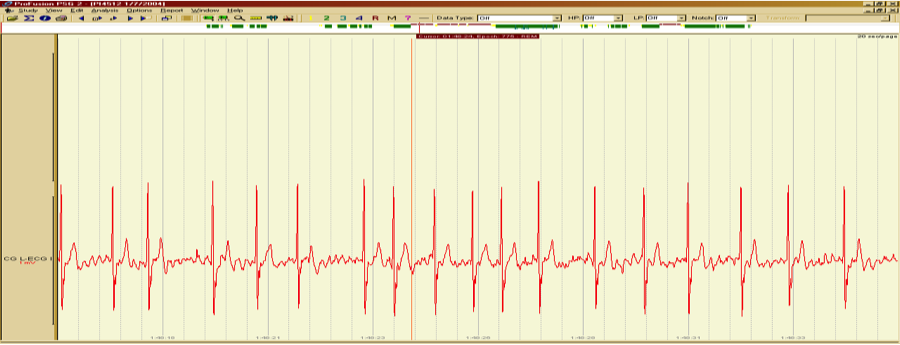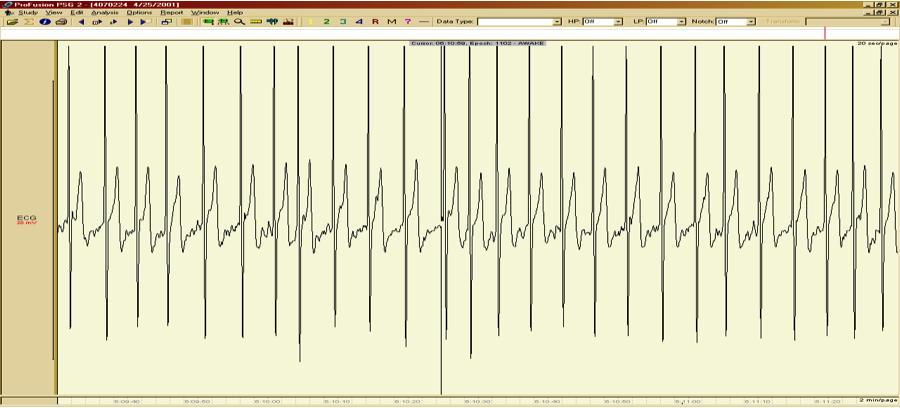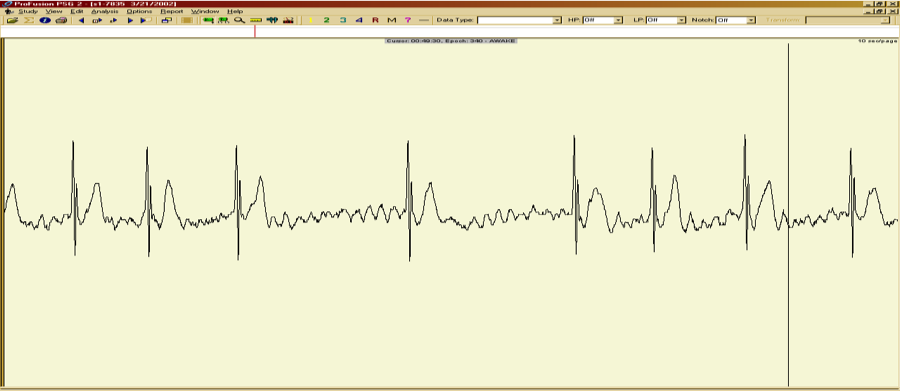Childhood Adenotonsillectomy Trial
6.9 QS Form - Scoring Notes
The following are coded on the QS Form during the scoring of each study: Lights out time, Sleep onset time, and Lights on time: The time of lights out, sleep onset and lights on are recorded by the scorer on the QS form to assist in analysis of accuracy of reported time to bed and sleep latency.
QA Grade Review
The QA grades of the signal and study are assigned at the time of scoring. It is recognized that the scorer, who spends a longer time with each study, may disagree with the preliminary pass/fail review of the Chief Polysomnologist. This will be re-reviewed with the Chief Polysomnologist and final determination made. Unusual signals, questions not addressed in manual of operations will be addressed at weekly scoring meeting
| Signals | Approximate hours of usable signal in sleep |
Signal Quality |
|---|---|---|
| E1 | 1 2 3 4 5 | |
| E2 | 1 2 3 4 5 | |
| Chin | 1 2 3 4 5 | |
| C3 | 1 2 3 4 5 | |
| C4 | 1 2 3 4 5 | |
| O1 | 1 2 3 4 5 | |
| O2 | 1 2 3 4 5 | |
| F3 | 1 2 3 4 5 | |
| F4 | 1 2 3 4 5 | |
| T3 | 1 2 3 4 5 | |
| T4 | 1 2 3 4 5 | |
| M1 | 1 2 3 4 5 | |
| M2 | 1 2 3 4 5 | |
| ECG | 1 2 3 4 5 | |
| LLeg | 1 2 3 4 5 | |
| RLeg | 1 2 3 4 5 | |
| Snore | 1 2 3 4 5 | |
| *CannulaFlow | 1 2 3 4 5 | |
| *Airflow | 1 2 3 4 5 | |
| Chest | 1 2 3 4 5 | |
| ABD | 1 2 3 4 5 | |
| SUM | 1 2 3 4 5 | |
| Cap | 1 2 3 4 5 | |
| EtCO2 | 1 2 3 4 5 | |
| Oximetry | 1 2 3 4 5 | |
| Pleth | 1 2 3 4 5 | |
| Position | 1 2 3 4 5 | |
| Reference | 1=Good 2=Problem (If "2" explain in notes) |
- 1. Signal good for less than 25% of sleep time.
- 2. Signal good for 25% of sleep time.
- 3. Signal good for 50% of sleep time.
- 4. Signal good for 75% of sleep time.
- 5. Signal good for almost entire (95%) sleep time.
Overall Study Quality
- † (7) Outstanding. All signals ((EEG+M1,M2), both EOGs, chin, airflow, cannula flow, both belts, and oximetry) good for at least 6 hours lights off to lights on and almost entire (95%) sleep time.
- † (6) Excellent. At least one central EEG (C3 or C4), one EOG channel, chin, airflow, both belts or cannula flow, and oximetry good for 6 hours lights off to lights on and minimum of 75% of the sleep time.
- † (5) Very good. At least one central EEG (C3 or C4), one EOG, airflow, one belt (either thoracic or abdominal) or cannula flow, and oximetry good for 6 hours lights off to lights on and minimum of 50% of the sleep time
- † (4) Good. At least one central EEG (C3 or C4), one EOG, one respiratory channel (any flow (*) or either band), and oximetry good for 6 hours lights off to lights on and minimum of 50% of the sleep time
- † (3) Fair. At least one central EEG (C3 or C4), one respiratory channel (any flow (*) or either band), oximetry usable for minimum of 4 hours lights off to lights on OR study scored sleep/wake only (because of study-tolerance issues) with usable oximetry for > 75% of study duration.
Limited Scoring
Study is scored sleep - wake only when the technical quality of the EEG does not allow distinction between sleep stages, but allows a differentiation between sleep and wake. The time considered sleep will be marked as Stage 2. No arousals will be scored for these studies. Respiratory events will be scored as usual. Scoring a study “sleep-wake” requires approval by the C P or review with another scorer. Any study scored sleep - wake only will be given grade Fair regardless of the hours of scorable signal.
Arousals will be considered unreliable when the technical quality of the EEG does not allow differentiation of background changes in EEG from discrete periods of EEG acceleration. Scoring arousals unreliable will be checked “yes” on QS form. Studies may still be of sufficient quality to stage sleep.
Urgent Referrals – PSG Ineligible
Will be checked "yes" if any criteria for urgent as listed below are met:
- OAI > 20 or AHI > 30.
- Oxygen Saturation < 90% for > 2% TST.
- Heart rate < 40 bpm for ≥ 2 min
- Heart rate > 140 bpm for ≥ 2 min
- Other HR arrhythmia, heart block, Ventribular tachycardia, etc. observed.
Examples of heart rate extremes
Additional Scoring Notes re Limitations or Unreliability
Was the study scored with the minimal problems? The following boxes are checked when the scorer is unsure approximately 20% of the time (1 in 5) about classifying epochs/events when making a decision regarding each of the following:
- Wake - Sleep unreliable: when the clarity of the EEG makes distinguishing the transition from Stage Wake to sleep uncertain.
- Stage 1/Stage 2 unreliable: when K-complexes and sleep spindles do not have show their classical morphology and distinction between Stage 1 and Stage 2 is doubtful (characteristic for the studies with low voltage EEG).
- Stage 2/Deep Sleep unreliable: when distinction between Stage 2 and Deep Sleep is unreliable because of EEG artifact (usually due to the respiratory or sweat artifact on the EEG, and High Pass filter =1Hz used).
- REM/NonREM unreliable: when identification of Stage REM is unreliable (usually due to poor or missing EMG or when both EOGs are absent).
- Arousals unreliable: when the technical quality of the study does not allow one to distinguish discrete increases in EEG frequency from background changes in EEG. EEG still may be of sufficient quality to score stages. Studies with the physiological alpha intrusion will have arousals scored regardless of difficulty, Checking the “arousal unreliable”
- Arousals in REM unreliable: when EMG is artifactual or absent during all or REM portion of the study.
- Respiratory events/RDI unreliable: when due to the technical quality of the respiratory signals, distinctions between hypopneas and normal breaths are equivocal in over 20 % of scored events; also when the quality of the oximetry signal raises doubts about actual magnitude of desaturation linked with over 20 % of respiratory events (unstable baseline).
- Apnea/hypopnea unreliable – when airflow signal is artifactual or absent for over 20 % of scored respiratory events.
Unusual occurrences during sleep
Abnormal Awake EEG: when the waking EEG background rhythm consists of waves in the theta range. This should be distinguished from presence of theta waves as a result of excessive sleepiness, which will disappear after some period of sleep, and may indicate a neurological disorder or toxicity.
Was any data lost?
- Recording ended before participant awoke - the last epoch of the study is any stage of sleep; or when an arousal is seen in the last few epochs of the study and there is a question if the participant actually awoke or would have returned to sleep (i.e., lack of sustained activity indicating “out of bed.”).
- Loss of the data at the beginning, end or during study - indicates a loss of the data due to poor technical quality of the signals for >30 minutes.
Flow Limitation
Flow limitation, as seen by the nasal cannula, which is not associated with respiratory events, and occurs in more than 10% of sleep time.
Study-by-Study Outlier Identification
The presence of the following potential outliers will be identified immediately after each study is scored and a report is generated:
- 0 % of the any sleep stage
- 90 % of any Non-REM sleep stage
- > 60 % of Stage REM
- OAI or AHI = 0
- Obstructive apnea index > 80
- Central apnea index > 40
- Minimum desaturation < 40 %
- AI (Arousal Index ) < 3
- Apnea or hypopnea duration < 5 s.
- Oxygen saturation = 0.
- PLM Index > 25
- Length of respiratory event > 30 seconds
If any of the outliers are found, the scorer will review the study and identify the source. Any errors in scoring or editing will be corrected. New reports will be generated and saved. Scorer will make notation on QS form if the outlier is real, i.e. 0% REM real, RDI = 0 real.



